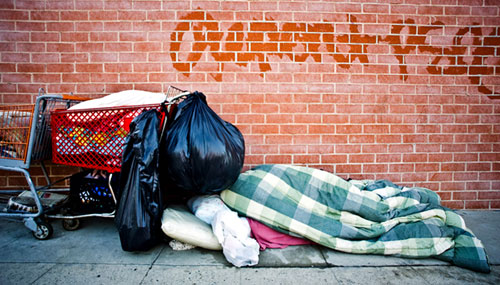East West Lifestyle
Homelessness Doesn’t Mean Hopelessness
By Melody Yuan

Ways to help the homeless get off the streets and onto a path of stability.
Amiyoko Shabazz takes a moment to scan the audience as she gracefully steps up to the microphone. Her smile beams despite the dark words, “My name is Amiyoko, and I come from a history of trauma.”
Her hands grip the side of the podium as she continues on, “I come from a broken home, been in and out of foster care, and had three children at a young age. But what’s important today is that my children and I have survived multiple instances of trauma.”
At the 2016 Dinner with a Cause gala to benefit the Downtown Women’s Center, Shabazz along with others at the event discuss the importance of and strategies required to alleviate Los Angeles’ growing homeless issue.

"Homelessness has many faces, and it rarely results from one singular event."
Los Angeles County has more than 43,000 individuals living on the street or in shelters, with downtown seeing more than 4,700 of such individuals. Zoom out to the state level where California has 113,952 homeless and make up approximately 20 percent of the nation’s homeless population, which as of 2014 stands at nearly 600,000.
In contrast to the improvement in employment numbers, the number of people in poor households, especially families, grew over the past few years. Housing cost burdens continue to plague communities, and the implementation of emergency shelters, transitional housing, rapid re-housing and permanent supportive housing as mandated by the Homeless Emergency Assistance and Rapid Transition to Housing Act (HEARTH) has grown significantly since it passed in 2009.
In 2015, the total amount of funding the federal government used to address homelessness came to $4.5 billion. In L.A. County alone, the count of those living on the streets grew by 1,400 due to funding cuts to transitional housing and increased efforts to build permanent housing. According to the National Alliance to End Homelessness, each homeless person costs taxpayers $14,480 per year primarily for overnight jail and average three nights per visit to the hospital, which costs taxpayers around $9,000.
The numbers are staggering, and the negative economic impact homelessness brings to the nation has economists and politicians working around the clock to resolve this issue. Beyond each statistic is a person who is a veteran, a senior citizen, a mentally ill patient, a single mother, an abused child, and the list goes on.
“People just don’t understand,” says Amiyoko Shabazz, who was homeless over the course of five years and is now an advocate for the Downtown Women’s Center, which East West Bank sponsors. “Homelessness has many faces, and it rarely results from one singular event. Usually it’s the consequence of many situations and factors that push people out onto the streets.”
In the last election alone, Proposition HHH which passed in November, proposed a total of $1.2 billion in bond measures to provide funding to build housing infrastructures necessary to prevent chronic homelessness in the L.A. County. The city needs more than 10,000 units of Permanent Supportive Housing to help its homeless residents and without the bond, only 3,000 units will be financed across 10 years. Homelessness is an issue that is on the radar of many residents across the country, with awareness rising as a direct result of a visible increase in the homeless population and the voices of active organizations and speakers such as Amiyoko Shabazz.
Los Angeles needs more than 10,000 units of Permanent Supportive Housing.

Among the many organizations and programs that were developed to address the issue, one that has a unique approach was spearheaded by the Real Change Movement. As part of a collaborative effort involving the City of Pasadena, County of Los Angeles, East West Bank and organizations like Flintridge Center, IPS Group and Pasadena City College, the movement is aimed at raising public awareness and advocating for donations where it counts. Despite their relatively blanketed slogan, “Homes for the homeless. Powered by change,” the organization has come up with a meter donation program, the first of its kind in Los Angeles County. The following situation happens all too often in large cities: a homeless person solicits for money and asks for help from pedestrians and drivers. There are those who give and those who refuse, but at the end of the day, the givers remain uncertain of how their money will be spent.
To discourage the homeless from asking for money, and to encourage those who are compassionate about the issue but uncertain about how to donate effectively, the Real Change Movement hopes that their donation meters will continue being implemented across the city. All proceeds going into these orange meters directly benefit the homeless via programs that provide homes and shelters. Regardless of pocket change or credit card payments, donors can be rest assured that their funds will benefit the homeless in an applicable way.
“Homelessness is never one dimensional,” says Jonathan Scherck, Housing Navigator for the Union Station Homeless Services. “There is just so much involved to try and get people off the streets, and even if they do find temporary shelter, they’re prone to relapses into homelessness.” Union Station Homeless Services is one of the homeless programs that receives funds from the Real Change Movement. Although, admittedly, the orange meters themselves will not be the driving force to eradicate homelessness, every penny counts.
Today, Shabazz has a degree and is further studying computer programming. Her son is attending University of California, Davis. The family shares a warm home. As Shabazz ardently recalls, “if it weren’t for the communities and the kindness of people’s hearts who helped me along the way, I wouldn’t be here today. Today, I’m not homeless. I’m creating a legacy.”

